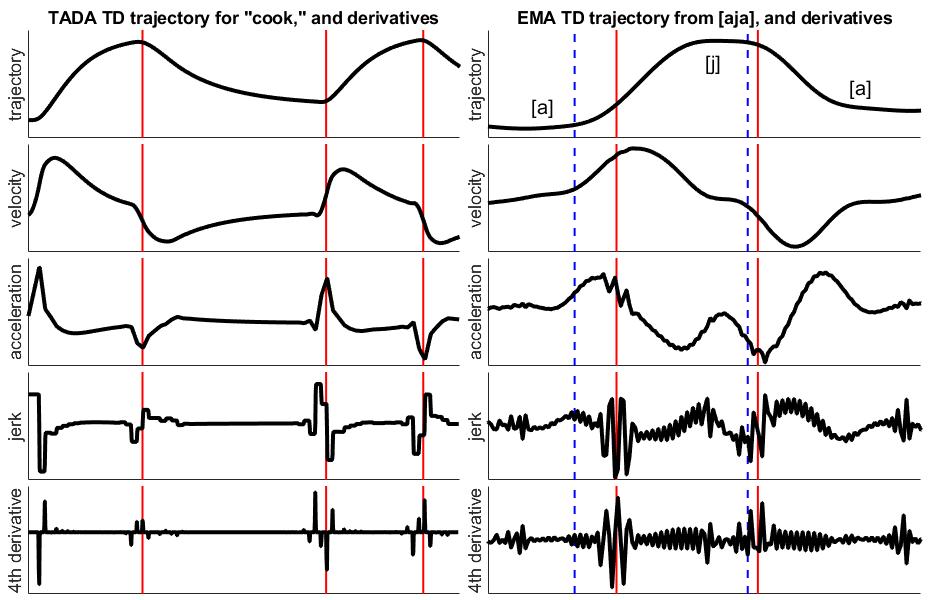News
Seung-Eun Kim and Dr. Sam Tilsen present poster at the 12th International Seminar on Speech Production
Seung-Eun Kim and Dr. Sam Tilsen present poster titled "Temporal localization of syntactically conditioned prosodic information" at the 12th International Seminar on Speech Production (ISSP 2020), held virtually on Dec 14-18, 2020.
Poster Abstract:
This study investigates when in time the prosodic correlates of a syntactic contrast can be detected in acoustic and articulatory signals.
Specifically, we attempt to localize information that distinguishes non-restrictive relative clauses (NRRCs) and restrictive relative clauses (RRCs), examples of which are shown in (1). On several accounts (e.g., Selkirk 2005), the two types of relative clauses differ in prosodic phrase structure, and this predicts that the utterances in (1) should differ in the vicinity of the phrase boundaries before (B1) and after (B2) the relative clause. To test this prediction, we used a neural network-based analysis procedure.
The results showed that for some speakers, the syntactically conditioned prosodic information was distributed in a wide region around prosodic boundaries, while for the other speakers, the information was more concentrated at specific locations. For those speakers who showed concentrated patterns, there was variation in where prosodic information was located relative to phrase boundaries.
16th December 2020
Dan Cameron Burgdorf and Dr. Sam Tilsen present poster at ISSP 2020
Dan Cameron Burgdorf and Dr. Sam Tilsen presented a poster titled "Compensation for Altered Feedback in Vowels and Glides" at the 12th International Seminar on Speech Production (ISSP 2020), held virtually Dec 14-18, 2020
Poster Abstract:
This study uses altered feedback to investigate whether there is difference between vowels and glides in the priority of auditory feedback.
It was hypothesized that auditory feedback is more important in the production of vowels than glides, and thus compensatory responses to feedback perturbation were predicted to be larger for vowels than for glides. Participants were cued to repeat the nonce words /biʌ/ and /bjʌ/, and their productions were altered to increase F2 by 250Hz and decrease F1 by 120Hz, effectively making the target sounds more high and more front.. The alteration was limited to a 100ms period beginning from the acoustic release of /b/.
Whether participants exhibited the hypothesized asymmetry in compensatory response depended on their vowel durations. Participants who produced shorter /i/ vowels compensated more for the vowel than the glide, as expected. Participants who produced longer /i/ vowels generally showed less compensation for the vowel than for the glide, likely because the alteration was only applied during part of their vowels.
14th December 2020
Seung-Eun Kim and Dr. Sam Tilsen present poster at the 179th Meeting of the Acoustical Society of America
Seung-Eun Kim and Dr. Sam Tilsen presented a poster titled "Phonetic evidence for categorical differences in prosodic structure" at the 179th Meeting of the Acoustical Society of America, held virtually Dec 7-11, 2020
Poster Abstract:
An experiment was conducted to assess phonetic evidence for categorically distinct prosodic structures associated with two types of relative clauses in English. Non-restrictive relative clauses (NRRCs) and restrictive relative clauses (RRCs) have been argued to be typically produced with different prosodic phrase structures.
To test whether there is evidence for this, productions of the two relative clauses were elicited. A wide range of variation in speech rate was elicited by using a moving visual analogue which cued participants for rate variation. Acoustic and articulatory data were collected from twelve participants.
We assessed whether the functional relations between speech rate and various phonetic measures at phrase boundaries differed by syntactic context. In addition, linear and sigmoidal models were fit to each of the articulatory and acoustic measures within each syntactic context, and the corrected Akaike Information Criterion (AICc) was used to determine whether the sigmoidal model provides a substantially better fit than the linear model.
Although most of the phonetic measures showed a significant difference between the two syntactic structures, which provides some evidence for distinct prosodic categories, the non-linearity analyses in both structures showed weak evidence for categorical variation in prosodic structure.
10th December 2020

Dan Cameron Burgdorf presents poster at the 117th Acoustical Society of America Meeting
Dan Cameron Burgdorf presented a poster titled "Using High-Order Derivatives of Articulatory Trajectories to Identify Gesture Onset" at the 179th Acoustical Society of American Meeting, held virtually Dec 7-11, 2020
Poster Abstract:
Articulatory trajectories are useful for measuring speech properties, but come with complications: a given trajectory may be influenced by multiple articulators and/or multiple overlapping gestures. Standard procedure is to identify landmarks from the trajectory and its velocity.
I present a new procedure: higher order derivatives can be used to identify gesture onsets. High order derivatives are generally associated with signal noise, and therefore not considered to be meaningful. More broadly, however, they reflect the jaggedness or un-smoothness of a signal, which can derive from sources other than random noise.
I demonstrate that such jaggedness at gesture onsets is both predicted by the task dynamic model of speech production (Saltzman & Munhall 1989) and observed in real EMA data. Articulator trajectories generated with the Task Dynamics Application (TADA) Matlab implementation of this model (Nam & Goldstein 2004) show a pattern of increasing activity around changes in gestural activation and decreasing activity elsewhere as successive derivatives are taken.
This was confirmed in EMA data on glides, demonstrating not only that the effect is real, but that it can be measurable above other noise. Activation noise can be isolated with targeted filtering, and may yield new insights into speech motor control.
9th December 2020
